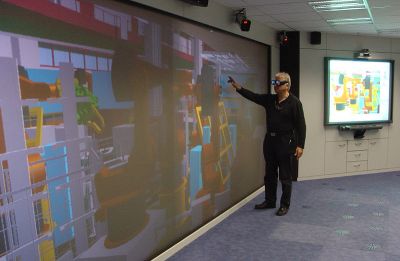Très Cloîtres Numérique , due to
be launched this summer, is a 'living memorial' to a neglected quarter
of Grenoble, says VENTURI Project Coordinator Paul Chippendale. The
project was designed to appeal "to people familiar with the
neighbourhood as well as those who are interested in Grenoble’s rich
cultural heritage and human history."
Participants can use a tablet or smartphone to look at the city
through a virtual lens. The modern-day scene that they can see through
their device’s camera is overlaid with historical photographs and 3D
reconstructions of ancient buildings, allowing the users to look at
their surroundings, going backwards through time. Local schoolchildren
have collected photographs and memories from their parents and
grandparents in order to preserve their memories for future generations.
Beyond Smartphones and Tablets: Wearable AR
Whilst Très Cloitres Numérique is ambitious, it still relies on the
user looking through the screen of their smart device. "But rather than
having to view the world through your device," says Mr Chippendale, "it
should be possible to experience an augmented environment seamlessly
through smart glasses, watches and earpieces.
"The customary 'letterbox' paradigm of AR – holding up your
Smartphone and using it as a magic looking glass – certainly makes AR
accessible to the masses, but in my opinion it is not a comfortable
experience. Even though I work in this field I still do not use AR Apps
in my everyday life," says Mr Chippendale. "They are just too generic
and do not give me the information that I need according to where I am,
what I am doing and what I enjoy.
"However, I do believe that this is about to change. In VENTURI, we
have been exploring cutting edge 'reality sensing' through
computer-vision and sensor fusion, and have tied this together with
intuitive 'world augmentation' through 3D audio, Smartwatch interaction
and HMDs like GoogleGlass.
"It's the aim of the VENTURI project to create augmented reality
applications that blend seamlessly with the user's interaction with the
real world." Rather than needing to stop to look at their smartphone or
tablet, users would receive information that would enhance their
experience of the world around them through an earpiece or smart
glasses.
Using AR to Help Customers.
It's not only virtual history galleries that can be created using
the VENTURI project’s augmented reality systems. Companies like
Volkswagen, Audi and
IKEA are working with project partner
Metaio
to create exciting new tools. For example, Audi customers can take a
virtual tour of their new vehicle to learn its features and Volkswagen
allows users to customise a car before ordering. IKEA and Mitsubishi
both allow clients to see how their products would look in their homes
or offices, before buying.
By working with Metaio and Sony, the VENTURI project is creating
what they believe will be the first generation of ubiquitous AR tools.
Says Paul Chippendale:
"Thanks to Sony's participation in VENTURI, we
have had privileged access to their future vision of wearable devices,
ranging from smart life logging bands (wrist-worn devices that log a
user's activity) to advanced head mounted displays. We have been using
this insight together with Metaio's strong market knowledge, to create
personalised AR content according to a user's social profile, the
current environmental and what it is that they're currently doing."

